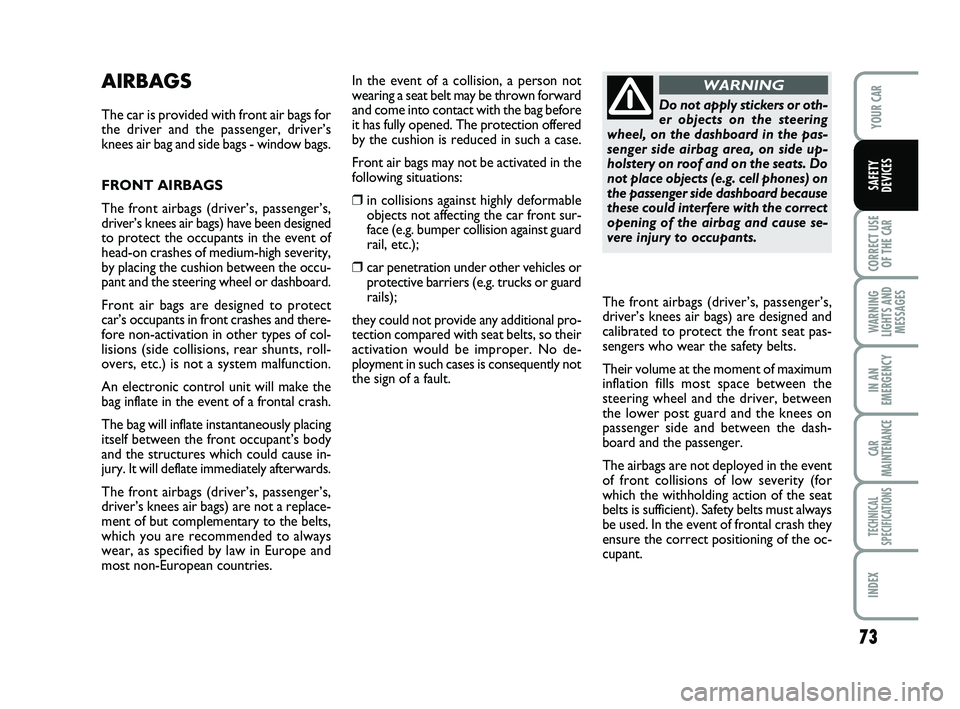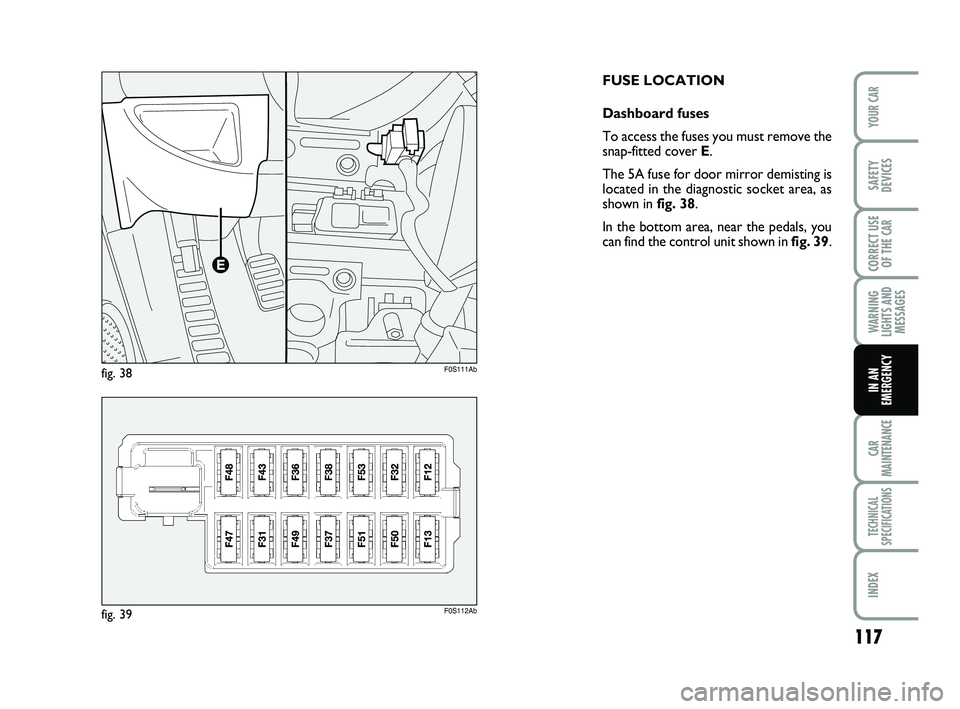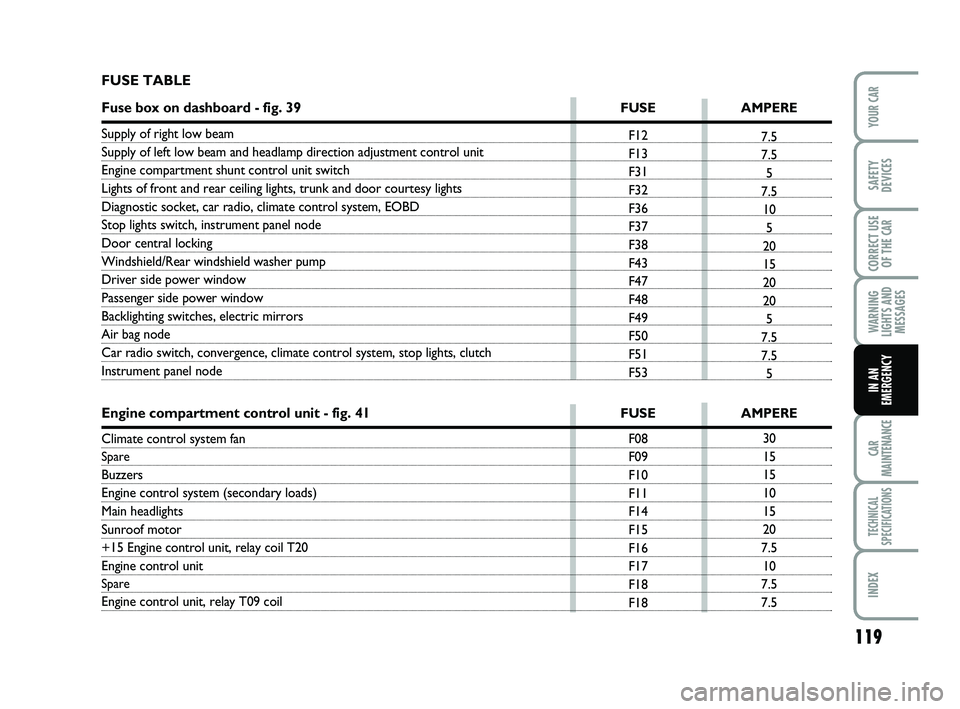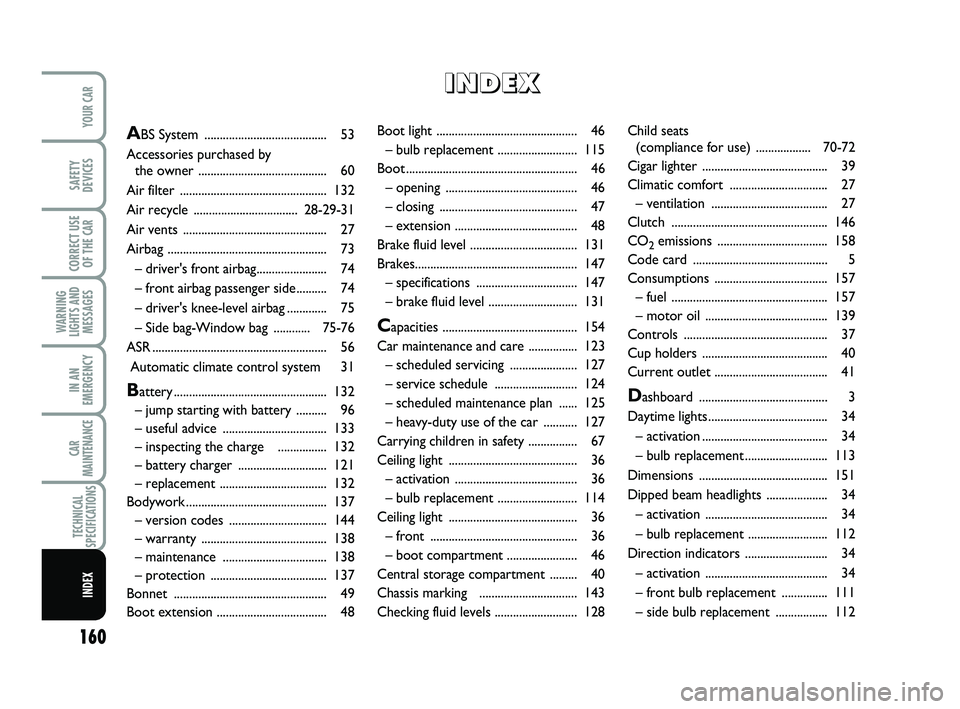dashboard Abarth 500 2009 Owner handbook (in English)
[x] Cancel search | Manufacturer: ABARTH, Model Year: 2009, Model line: 500, Model: Abarth 500 2009Pages: 170, PDF Size: 3.04 MB
Page 68 of 170

67
CORRECT USE
OF THE
CAR
WARNING
LIGHTS AND
MESSAGES
IN AN
EMERGENCY
CAR
MAINTENANCE
TECHNICAL
SPECIFICATIONS
INDEX
YOUR CAR
SAFETY
DEVICES
SEAT BELTS MAINTENANCE
Observe the following:
❒always use the belt with the tap taut and
never twisted; make sure that it is free
to run without impediments;
❒replace the belt after an accident of a
certain severity even if it does not ap-
pear damaged. Always replace the belt
if the pretensioners were deployed.
❒to clean the belt, wash by hand with wa-
ter and mild soap, rinse and leave to dry
in the shade. Do not use strong deter-
gents, bleach, paints or any other sub-
stance which could damage the belt fi-
bres;
❒keep the reels dry: correct operation
may only be ensured if the reels are dry;
❒replace the seat belt when showing sig-
nificant wear or cut signs.
CARRYING CHILDREN
SAFELY
For optimal protection in the event of a
crash, all passengers must be seated and
wearing adequate restraint systems.
This is even more important for children.
This prescription is compulsory in all EC
countries according to EC Directive
2003/20/EC.
A child’s head is larger and heavier in pro-
portion to his/her body and the child’s
muscular and bone structures are not ful-
ly developed.
For this reason, they require restraint sys-
tems which are different from those used
by adults to protect them in the event of
an accident.
The research results in relation to the best
protection for children is illustrated in Eu-
ropean Regulation ECE-R44 which divides
the restraint systems into five groups in
addition to making their use compulsory:
Group 0 - 0-10 kg in weight
Group 0+ - 0-13 kg in weight
Group 1 9-18 kg in weight
Group 2 15-25 kg in weight
Group 3 22 - 36 kg in weight
SEVERE DANGER: Do not
arrange child seats facing
backwards on the front seat
if the passenger’s airbag is
on. Deployment of the
airbag in an accident could
cause fatal injuries to the baby. It is
advisable to carry children on the rear
seat, which is the most protected po-
sition in the event of an accident.
Child seats must not be fitted on the
front seat of cars provided with pas-
senger air bag, whose deployment in
an accident could cause fatal injuries
to the baby. If necessary, children can
stay on the front seat, if the passen-
ger’s airbag can be disabled. Verify
that the airbag is actually deactivat-
ed, observing the warning light
Fon
the dashboard (see “Front airbag -
passenger side” at paragraph “Front
airbags”). Move the passenger’s seat
as far back as possible to avoid con-
tact between the cradle and the dash-
board.
WARNING
063-078 ABARTH 500 GB 29-04-2009 9:42 Pagina 67
Page 74 of 170

73
CORRECT USE
OF THE
CAR
WARNING
LIGHTS AND
MESSAGES
IN AN
EMERGENCY
CAR
MAINTENANCE
TECHNICAL
SPECIFICATIONS
INDEX
YOUR CAR
SAFETY
DEVICES
AIRBAGS
The car is provided with front air bags for
the driver and the passenger, driver’s
knees air bag and side bags - window bags.
FRONT AIRBAGS
The front airbags (driver’s, passenger’s,
driver’s knees air bags) have been designed
to protect the occupants in the event of
head-on crashes of medium-high severity,
by placing the cushion between the occu-
pant and the steering wheel or dashboard.
Front air bags are designed to protect
car’s occupants in front crashes and there-
fore non-activation in other types of col-
lisions (side collisions, rear shunts, roll-
overs, etc.) is not a system malfunction.
An electronic control unit will make the
bag inflate in the event of a frontal crash.
The bag will inflate instantaneously placing
itself between the front occupant’s body
and the structures which could cause in-
jury. It will deflate immediately afterwards.
The front airbags (driver’s, passenger’s,
driver’s knees air bags) are not a replace-
ment of but complementary to the belts,
which you are recommended to always
wear, as specified by law in Europe and
most non-European countries.In the event of a collision, a person not
wearing a seat belt may be thrown forward
and come into contact with the bag before
it has fully opened. The protection offered
by the cushion is reduced in such a case.
Front air bags may not be activated in the
following situations:
❒in collisions against highly deformable
objects not affecting the car front sur-
face (e.g. bumper collision against guard
rail, etc.);
❒car penetration under other vehicles or
protective barriers (e.g. trucks or guard
rails);
they could not provide any additional pro-
tection compared with seat belts, so their
activation would be improper. No de-
ployment in such cases is consequently not
the sign of a fault.
Do not apply stickers or oth-
er objects on the steering
wheel, on the dashboard in the pas-
senger side airbag area, on side up-
holstery on roof and on the seats. Do
not place objects (e.g. cell phones) on
the passenger side dashboard because
these could interfere with the correct
opening of the airbag and cause se-
vere injury to occupants.
WARNING
The front airbags (driver’s, passenger’s,
driver’s knees air bags) are designed and
calibrated to protect the front seat pas-
sengers who wear the safety belts.
Their volume at the moment of maximum
inflation fills most space between the
steering wheel and the driver, between
the lower post guard and the knees on
passenger side and between the dash-
board and the passenger.
The airbags are not deployed in the event
of front collisions of low severity (for
which the withholding action of the seat
belts is sufficient). Safety belts must always
be used. In the event of frontal crash they
ensure the correct positioning of the oc-
cupant.
063-078 ABARTH 500 GB 29-04-2009 9:42 Pagina 73
Page 75 of 170

74
CORRECT USE
OF THE
CAR
WARNING
LIGHTS AND
MESSAGES
IN AN
EMERGENCY
CAR
MAINTENANCE
TECHNICAL
SPECIFICATIONS
INDEX
YOUR CAR
SAFETY
DEVICES
SEVERE DANGER: Do not
arrange child seats facing
backwards if the passenger’s
front airbag is on. Deploy-
ment of the airbag in an ac-
cident could cause fatal in-
juries to the baby. Always deactivate
the passenger’s airbag when placing
a child seat on the front seat. Move
the passenger’s seat as far back as
possible to avoid contact between the
cradle and the dashboard. Although
this is not mandatory by law, the
airbag should be immediately reacti-
vated when children are no longer
carried to ensure better protection to
adults.
WARNING
DRIVER’S FRONT AIR BAG fig. 12
It consists of an instant-inflating cushion
contained in a special recess in the cen-
tre of the steering wheel.
fig. 12F0S071Abfig. 13F0S072Ab
PASSENGER’S FRONT AIR BAG
fig. 13
It consists of an instant-inflating cushion
contained into a special recess in the dash-
board, this cushion has a volume bigger
than that of the driver.
063-078 ABARTH 500 GB 29-04-2009 9:42 Pagina 74
Page 118 of 170

117
WARNING
LIGHTS AND
MESSAGES
CAR
MAINTENANCE
TECHNICAL
SPECIFICATIONS
INDEX
YOUR CAR
SAFETY
DEVICES
CORRECT USE
OF THE
CAR
IN AN
EMERGENCY
FUSE LOCATION
Dashboard fuses
To access the fuses you must remove the
snap-fitted cover E.
The 5A fuse for door mirror demisting is
located in the diagnostic socket area, as
shown in fig. 38.
In the bottom area, near the pedals, you
can find the control unit shown in fig. 39.
fig. 38
E
F0S111Ab
fig. 39F0S112Ab
095-122 ABARTH 500 GB 29-04-2009 9:43 Pagina 117
Page 120 of 170

119
WARNING
LIGHTS AND
MESSAGES
CAR
MAINTENANCE
TECHNICAL
SPECIFICATIONS
INDEX
YOUR CAR
SAFETY
DEVICES
CORRECT USE
OF THE
CAR
IN AN
EMERGENCY
F12
F13
F31
F32
F36
F37
F38
F43
F47
F48
F49
F50
F51
F537.5
7.5
5
7.5
10
5
20
15
20
20
5
7.5
7.5
5
F08
F09
F10
F11
F14
F15
F16
F17
F18
F1830
15
15
10
15
20
7.5
10
7.5
7.5
FUSE TABLE
Fuse box on dashboard - fig. 39FUSE AMPERE
Supply of right low beam
Supply of left low beam and headlamp direction adjustment control unit
Engine compartment shunt control unit switch
Lights of front and rear ceiling lights, trunk and door courtesy lights
Diagnostic socket, car radio, climate control system, EOBD
Stop lights switch, instrument panel node
Door central locking
Windshield/Rear windshield washer pump
Driver side power window
Passenger side power window
Backlighting switches, electric mirrors
Air bag node
Car radio switch, convergence, climate control system, stop lights, clutch
Instrument panel node
Engine compartment control unit - fig. 41FUSE AMPERE
Climate control system fan
Spare
Buzzers
Engine control system (secondary loads)
Main headlights
Sunroof motor
+15 Engine control unit, relay coil T20
Engine control unit
Spare
Engine control unit, relay T09 coil
095-122 ABARTH 500 GB 29-04-2009 9:43 Pagina 119
Page 161 of 170

160
WARNING
LIGHTS AND
MESSAGES
YOUR CAR
SAFETY
DEVICES
CORRECT USE
OF THE
CAR
IN AN
EMERGENCY
CAR
MAINTENANCE
TECHNICAL
SPECIFICATIONS
INDEX
Boot light .............................................. 46
– bulb replacement .......................... 115
Boot ........................................................46
– opening ........................................... 46
– closing ............................................. 47
– extension ........................................ 48
Brake fluid level ................................... 131
Brakes..................................................... 147
– specifications ................................. 147
– brake fluid level ............................. 131
Capacities ............................................ 154
Car maintenance and care ................123
– scheduled servicing ...................... 127
– service schedule ........................... 124
– scheduled maintenance plan ...... 125
– heavy-duty use of the car ........... 127
Carrying children in safety ................ 67
Ceiling light .......................................... 36
– activation ........................................ 36
– bulb replacement .......................... 114
Ceiling light .......................................... 36
– front ................................................ 36
– boot compartment ....................... 46
Central storage compartment ......... 40
Chassis marking ................................ 143
Checking fluid levels ........................... 128Child seats
(compliance for use) .................. 70-72
Cigar lighter ......................................... 39
Climatic comfort ................................ 27
– ventilation ...................................... 27
Clutch ................................................... 146
CO
2emissions .................................... 158
Code card ............................................ 5
Consumptions ..................................... 157
– fuel ................................................... 157
– motor oil ........................................ 139
Controls ............................................... 37
Cup holders ......................................... 40
Current outlet ..................................... 41
Dashboard .......................................... 3
Daytime lights....................................... 34
– activation......................................... 34
– bulb replacement........................... 113
Dimensions .......................................... 151
Dipped beam headlights .................... 34
– activation ........................................ 34
– bulb replacement .......................... 112
Direction indicators ........................... 34
– activation ........................................ 34
– front bulb replacement ............... 111
– side bulb replacement ................. 112
ABS System ........................................ 53
Accessories purchased by
the owner .......................................... 60
Air filter ................................................ 132
Air recycle ..................................28-29-31
Air vents ............................................... 27
Airbag .................................................... 73
– driver's front airbag....................... 74
– front airbag passenger side .......... 74
– driver's knee-level airbag............. 75
– Side bag-Window bag ............75-76
ASR ......................................................... 56
Automatic climate control system 31
Battery.................................................. 132
– jump starting with battery .......... 96
– useful advice .................................. 133
– inspecting the charge ................ 132
– battery charger ............................. 121
– replacement ................................... 132
Bodywork.............................................. 137
– version codes ................................144
– warranty ......................................... 138
– maintenance .................................. 138
– protection ...................................... 137
Bonnet .................................................. 49
Boot extension .................................... 48
I
I I I
N N N N
D D D D
E E E E
X X X X
160-168 ABARTH 500 GB 7-05-2009 16:45 Pagina 160